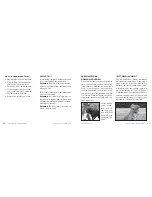
6
Sport Junior Dog Training Guide
customer service 1-800-456-4343
www.tritronics.com
Sport Junior Dog Training Guide
7
play. Most of the time you should end
the training session with play.
The way you praise should balance your
dog’s natural temperament. An excit-
able dog should have calming praise.
A dog who becomes quiet and sober
while trained should be livened up with
animating praise.
WHAT YOUR DOG NEEDS
BEFORE YOU START
The Lesson plan for each command
assumes that your dog already has an
understanding of the command word
before you start his e-collar Lessons. He
doesn’t have to be reliable at obeying.
But he needs some understanding of the
command. If he doesn’t have that under-
standing yet, then he’s not ready to train
on that particular command with the e-
collar.
What If He Doesn’t
Know the Command?
If you’re looking for some help with ba-
sic obedience to prepare your dog before
you start his e-collar training, there’s a
Bonus section on basic (non e-collar)
sessions a week. If you wait longer than
that between sessions your dog will have
trouble learning.
If your dog seems to be having trouble,
back up to an earlier stage in the Les-
son you’re working on, or even to an
earlier Lesson. Experienced dog trainers
regularly back up and repeat or simplify
earlier material for a dog. All dogs are
individuals and they make progress at
different rates.
There are many e-collar training pro-
grams; the program presented in this
booklet is just one way to start your e-
collar training. There are lots of good
programs out there and a variety of re-
sources in books, videos, the internet, as
well as help from a professional trainer
in your area. So feel free to look around
and don’t be locked in to any one meth-
od if you find something else that works
better for your dog.
HAPPY DOGS
Dogs learn best when they’re having a
good time, so include plenty of praise
and play when you train. Keep your dog’s
sessions short. You should to take a break
during a training session for a chance to






































